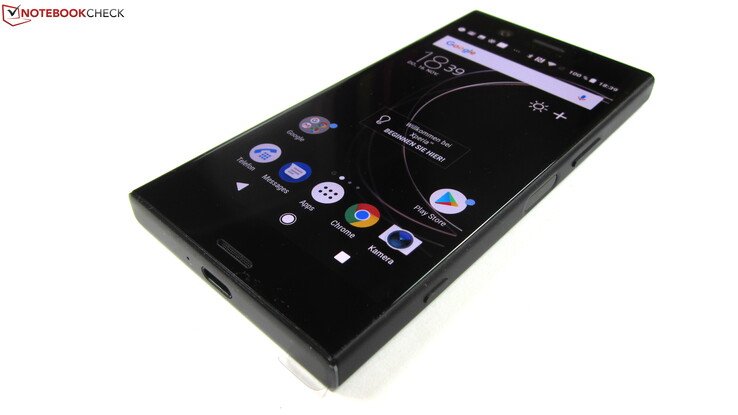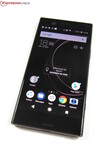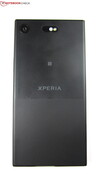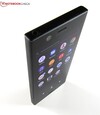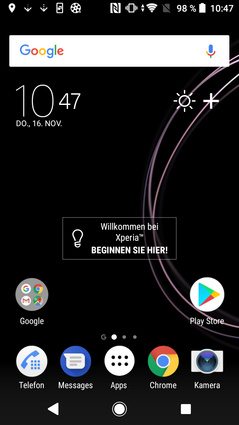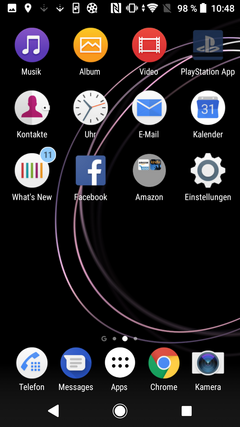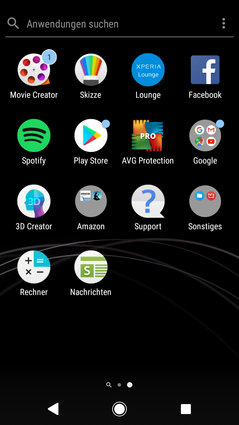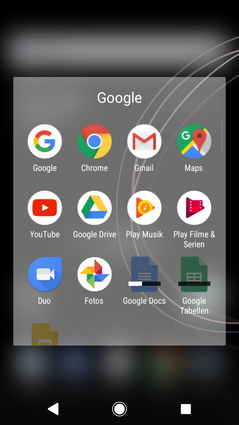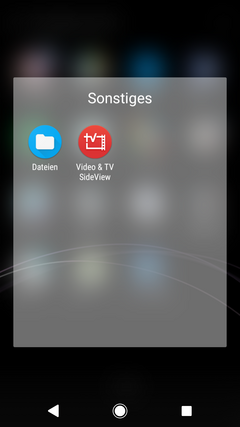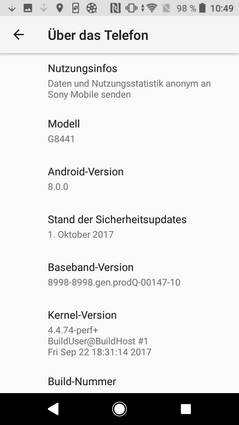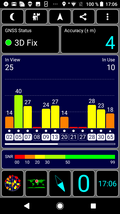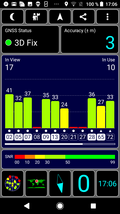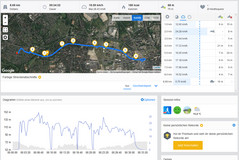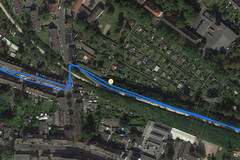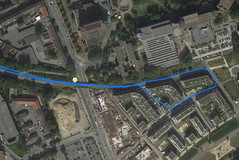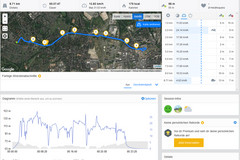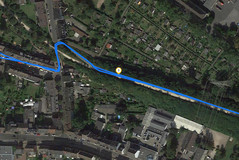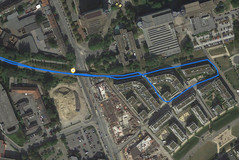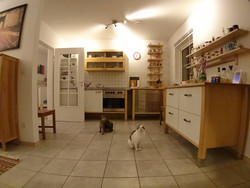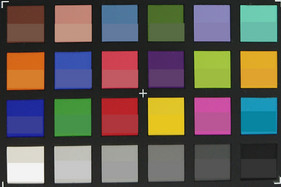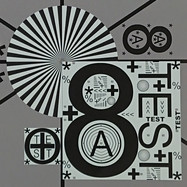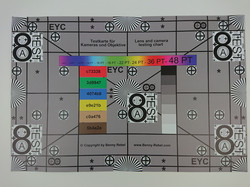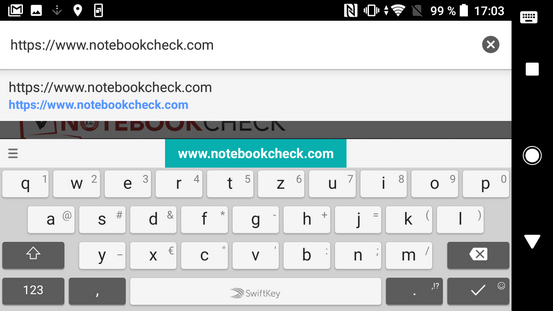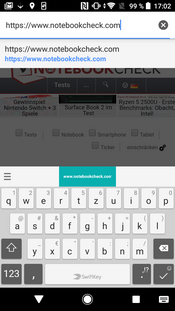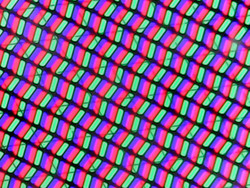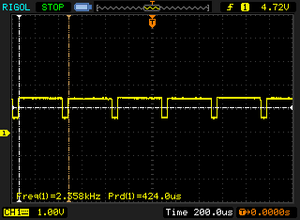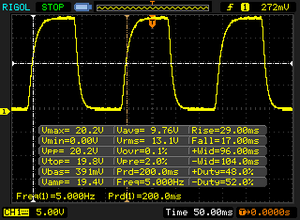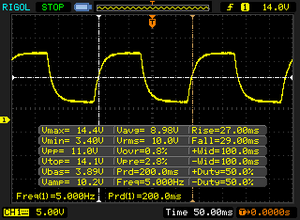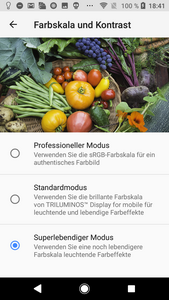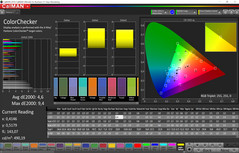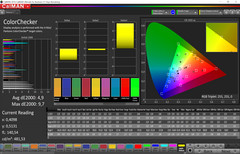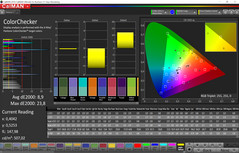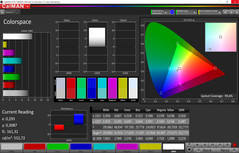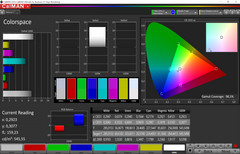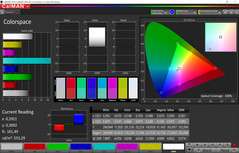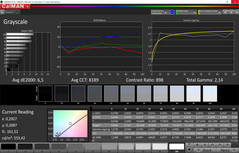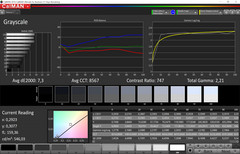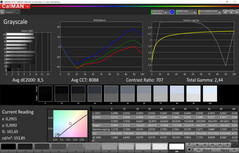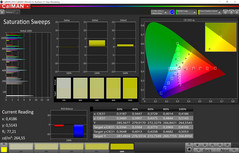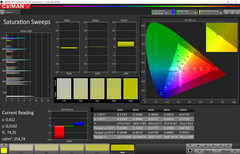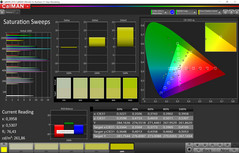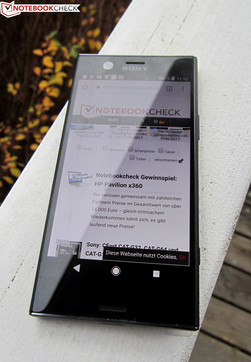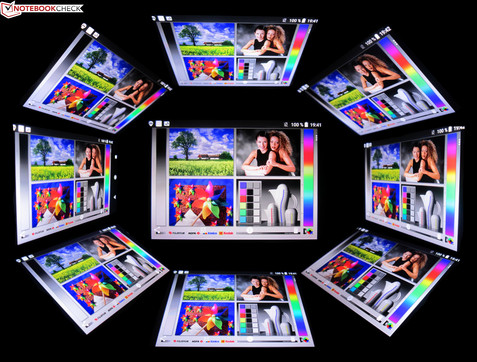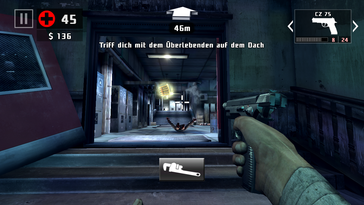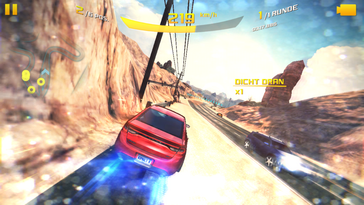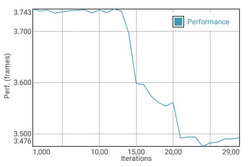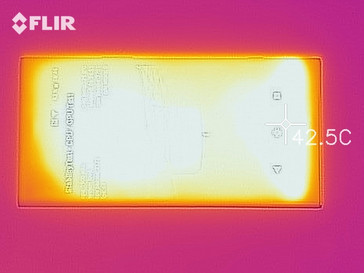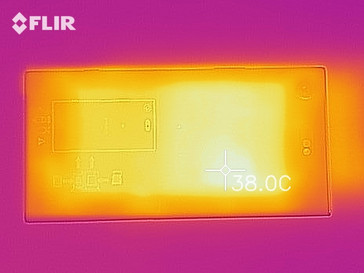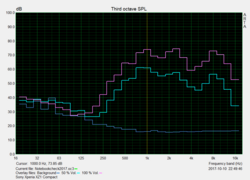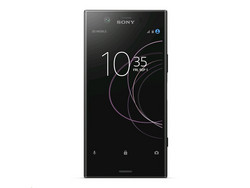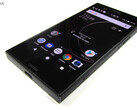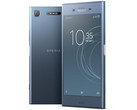Sony Xperia XZ1 Compact Smartphone Review

For the original German review, see here.
Small but powerful. In those few words, Sony sums up the virtues of their Xperia XZ1 Compact. As the product name indicates, the 4.6-inch Android device is one of the smaller smartphones on the market; but inside, it is one of the giants. With Qualcomm's Snapdragon 835 – the manufacturer's fastest SoC to date – an Adreno 540 GPU, and 4 GB of RAM, the Xperia XZ1 Compact is unquestionably a high-end smartphone.
Officially, Sony is charging 599 Euros (~$700; American version $599) for their mighty little device. Is that too much, or is the price justified? Our review seeks to answer that question as we compare the Xperia XZ1 Compact with a few other high-end smartphones that run on the same SoC – the OnePlus 5 and the Xiaomi Mi 6. We also weigh the new Sony device against the Samsung Galaxy S8 and the Apple iPhone 8, both of which offer a similar level of performance to our test candidate. Finally, no review of the Xperia XZ1 Compact would be complete without a thorough comparison against its 5.2-inch sister model, the Xperia XZ1.
Case
Smartphone design is a matter of taste. We bring up this truism here because one person's opinion of the Sony Xperia XZ1 Compact's unusual case may very well be the polar opposite of another's. With its boxy look, the Xperia XZ1 Compact is reminiscent of a mobile device from times past. But like a wolf in sheep's clothing, a top-tier smartphone is hiding unsuspected under this plain exterior.
Sony has packed the 4.6-inch device into a well-manufactured rectangular case. The soft edges that are ubiquitous in today's smartphone market are nowhere to be found; only the long sides are slightly tapered. The sharp edges on the short sides are hardly suggestive of a luxury class device. With this austere design, the smartphone is not exactly comfortable to hold either.
The relatively broad frame above and below the display takes some getting used to as well. The fact that it is even broader at the bottom (almost 1.5 cm/~0.6 in) than at the top (around 1.3 cm/~0.5 in) does not make a great deal of sense, given that the Android keys are not physical buttons, but on-screen elements. The smartphone's boxy design also makes it feel substantially thicker than 9.3 mm (~0.37 inches).
That said, there are many aspects that are beyond criticism in terms of the casing. For one thing, it is IP65/68 dust- and water-resistant. Sony has also mounted the Xperia XZ1 Compact's camera flush with the case, so the device can lie flat on level surfaces without wobbling around. The camera on our test device's sister model, the Xperia XZ1, lacks this agreeable quality. The case's stability is faultless as well – all our attempts to twist or otherwise warp the Xperia XZ1 Compact were futile.
The Xperia XZ1 Compact comes in four colors: White Silver, Black, Horizon Blue, and Twilight Pink.
Connectivity
With its high-end Qualcomm Snapdragon 835 SoC, integrated Adreno 540 graphics chip and 4 GB of main memory, the Xperia XZ1 Compact is a very fast smartphone. The storage space, on the other hand, is... well, compact. Of the nominal 32 GB of storage, Android 8.0 and the pre-installed apps already eat up 9.3 GB, leaving less than 23 GB available to the user. However, a microSD card can add up to 256 GB worth of space. Because the microSD card can only be formatted as portable storage, only media files can be stored there – no apps. A nano-SIM slot is located directly adjacent to the microSD slot.
The USB port supports only 2.0 speeds, but its rotationally-symmetrical Type-C connection allows the user to plug in cables and devices without worrying about the proper orientation. Additionally, the smartphone supports Quick Charge 3.0 and USB-OTG, enabling it to interface well with external storage and input devices. The power button doubles as a fingerprint reader.
Software
The Xperia XZ1 Compact runs the new Android 8.0 Oreo operating system. Given that the successor to Android Nougat has yet to find its way into almost any other smartphone, whether straight out of the factory or by means of an update, the Xperia XZ1 Compact is one of the very first devices to run the new OS. Sony has left the brand new Android system almost entirely as-is, just throwing in a few proprietary apps such as Xperia Lounge. When we wrote our original review, the security patches were dated October 1st 2017 – thoroughly up-to-date at the time.
Communication and GPS
The Xperia XZ1 Compact is equipped with a modern communications module that supports the WLAN standard 802.11ac, NFC, Bluetooth 5.0 and LTE Category 15. The latter brings the smartphone's download speeds to up to 800 MBit/s, while upload processes take place at up to 80 MBit/s. Unfortunately, Sony does not specify which frequencies the wireless module supports. We can attest that within our rural Vodafone network, the reception was always stable and clear.
Thanks to MIMO technology and the smartphone's support for the 5 GHz frequency band, the Xperia XZ1 Compact received data from our Linksys EA8500 reference router at a breakneck 521 MBit/s – one of the highest speeds of any device on the market. When transmitting, the Sony phone even reached up to 669 MBit/s, landing first place in our ranking.
| Networking | |
| iperf3 transmit AX12 | |
| Sony Xperia XZ1 Compact | |
| Samsung Galaxy S8 | |
| OnePlus 5 | |
| Xiaomi Mi 6 | |
| Sony Xperia XZ1 | |
| Apple iPhone 8 | |
| iperf3 receive AX12 | |
| Apple iPhone 8 | |
| Xiaomi Mi 6 | |
| Sony Xperia XZ1 Compact | |
| Sony Xperia XZ1 | |
| OnePlus 5 | |
| Samsung Galaxy S8 | |
The Xperia XZ1 Compact determines its current location by means of GPS, GLONASS and BeiDou. In our tests, these systems enabled the smartphone to ascertain its position quickly and with an accuracy of up to 3 meters (~10 ft).
In order to test the smartphone's positioning abilities in everyday use, we took it on a bike ride along with our professional navigation device, the Garmin Edge 500. En route, the Xperia XZ1 Compact occasionally showed us cycling through the walls of a building or pedalling through greenery rather than along the bike path. But overall, the GPS is so precise that it recorded almost the same exact route as the Garmin Edge 500. Any high-end smartphone should perform this well.
Phone Function and Call Quality
The Xperia XZ1 Compact is a good phone for making calls. If you hold the smartphone to your ear, both sides of the conversation are clearly audible and easily intelligible, even in louder environments. In quieter surroundings, voices emanating from the speaker are also easily understood. Both normal calls and conversations over speakerphone were accompanied by a small amount of static, but this was hardly noticeable and not at all bothersome.
Cameras
The Xperia XZ1 Compact is equipped with a 19 megapixel camera with a Sony Exmor RS chip and f/2.0 aperture. The Xperia XZ1 has the same camera. There is neither a dual camera nor optical image stabilization. Still, in good lighting, the 19 megapixel camera takes good shots. The images' natural colors are especially appealing. Unfortunately, fine details tend to appear a little washed out. In less optimal lighting environments, the lens still does its job well, even if the image noise does intensify.
The Xperia XZ1 Compact also scores points for its camera module's 3D scan function. Alongside Android 8.0, this is certainly one of the smartphone's unique selling points. The 3D app, called 3D Creator, comes pre-installed and can be used to create three-dimensional images (of faces, for example). The app includes a comprehensive tutorial, and during a 3D photo shoot, tips and suggestions are listed on the side of the screen. After a short period of training, we managed some shots that were not half bad. Once completed, these 3D scans can be embedded in a video, made into a GIF, or posted on social networks.
Another special feature of the camera is its super slow motion recording capability. In this mode, it can capture 960 frames per second – but it cannot take shots at any resolution level higher than HD, and the image quality is not very good. Conventional video recordings, on the other hand, can be taken at up to 4K resolution and 30 frames per second. These videos consistently look good.
The 8 MP front camera is fitted with a 120 degree wide angle lens. In good lighting, this lens also takes good shots. It comes with useful features for selfies, including smile recognition and the ability to automatically track a moving object (object tracking). In the camera menu, the user can also activate AR effects and place virtual objects in photos. For example, you can put a pirate's hat on someone's head, let fish swim through the picture, or add comic book effects like laser eyes. However, in poor lighting image noise creeps in quickly here too.
We always conclude our camera tests by analyzing the camera's performance under controlled lighting conditions. We evaluate the image colors with X-Rite ColorChecker Passport, and assess the image sharpness with our test chart.
In terms of color representation, the Xperia XZ1 Compact means well. With the exception of light gray tones, the smartphone always renders colors a little too intensely – but not so much as to be over-the-top. The results still look good here. Capturing images with the correct level of sharpness is a real challenge for our smartphone. Transitions between image structures are at times fringed, at times blurred – but never pin sharp.
Accessories and Warranty
The Sony Xperia XZ1 Compact comes with a modular power supply (5V, 1.5A), a USB Type-C cable, headphones, and a quick start guide. On Sony's accessories website, you can buy a cover with a kickstand (SCSG60), a stereo Bluetooth headset (SBH24), and a stereo headset (STH32), among other things.
In Europe, the Xperia XZ1 Compact comes with a 24-month warranty. Accessories, including the battery and charger, are under warranty for just one year. The EU's 2-year retailer's warranty applies independent of Sony's coverage. The US version comes with a 12-month warranty. Please see our Guarantees, Return Policies & Warranties FAQ for country-specific information.
Input Devices & Handling
A smartphone with a form factor of just 4.6 inches has become a rare species on today's market – and that is especially true among the top tier. The Sony Xperia XZ1 Compact scores points right away here, seeing as its compact size makes it very easy to use one-handed. The fingerprint reader built into the power button unlocks the smartphone quickly and reliably.
Everything runs smoothly internally as well – and no wonder, given that the Xperia XZ1 Compact has such powerful hardware at its command: a Snapdragon 835 SoC, 4 GB of RAM and quick UFS memory. The smartphone reacts to input instantly, apps start up quickly, and the process of switching between apps takes place without any noticeable lag. The SwiftKey keyboard serves as the standard keyboard for the Xperia XZ1 Compact.
Display
The Xperia XZ1 Compact's IPS display operates at HD resolution (a "low" 1280x720 pixels), reaching a pixel density of 319 PPI on its diagonally-measured 4.6-inch screen. Its 5.2-inch sister model, the Xperia XZ1, offers a little more here: 1920x1080 pixels and 424 PPI.
With a pure white background, the Xperia XZ1 Compact's display glows at a very bright 560.4 cd/m² on average, even reaching up to 567 cd/m² in some spots. With bright and dark areas spaced out evenly to create more realistic image content (APL50), the screen's maximum brightness of 559 cd/m² is almost just as high. The Xperia XZ1 Compact's brightness distribution is 98% across the screen – a remarkably good result. In order to go easy on the user's eyes, by default the smartphone automatically adjusts its brightness level in proportion to the ambient light.
With a black value of 0.53 cd/m², the screen is not able to display dark areas of images as fully black – such is life with an OLED display. But in terms of its contrast ratio (1068:1), the IPS display still does its job well. From a subjective perspective, colors look vivid and crisp.
The display has just one clear shortcoming: At brightness settings of 25% or less, the screen exhibits PWM flickering. This could cause eye problems and/or headaches in sensitive users.
| |||||||||||||||||||||||||
Brightness Distribution: 98 %
Center on Battery: 566 cd/m²
Contrast: 1068:1 (Black: 0.53 cd/m²)
ΔE ColorChecker Calman: 4.6 | ∀{0.5-29.43 Ø4.78}
ΔE Greyscale Calman: 6.5 | ∀{0.09-98 Ø5}
Gamma: 2.14
CCT: 8189 K
| Sony Xperia XZ1 Compact IPS, 1280x720, 4.6" | Apple iPhone 8 IPS True Tone, 1334x750, 4.7" | OnePlus 5 AMOLED, 1920x1080, 5.5" | Xiaomi Mi 6 IPS, 1920x1080, 5.2" | Samsung Galaxy S8 Super AMOLED, 2960x1440, 5.8" | Sony Xperia XZ1 IPS, 1920x1080, 5.2" | |
|---|---|---|---|---|---|---|
| Screen | 34% | 24% | 23% | 22% | 3% | |
| Brightness middle (cd/m²) | 566 | 604 7% | 426 -25% | 620 10% | 566 0% | 620 10% |
| Brightness (cd/m²) | 560 | 580 4% | 431 -23% | 586 5% | 564 1% | 610 9% |
| Brightness Distribution (%) | 98 | 91 -7% | 93 -5% | 89 -9% | 94 -4% | 93 -5% |
| Black Level * (cd/m²) | 0.53 | 0.44 17% | 0.28 47% | 0.79 -49% | ||
| Contrast (:1) | 1068 | 1373 29% | 2214 107% | 785 -26% | ||
| Colorchecker dE 2000 * | 4.6 | 1.2 74% | 1.6 65% | 4.8 -4% | 2.7 41% | 4.2 9% |
| Colorchecker dE 2000 max. * | 9.4 | 2.3 76% | 4.1 56% | 8.8 6% | 5.4 43% | 5.8 38% |
| Greyscale dE 2000 * | 6.5 | 1.6 75% | 1.7 74% | 5.3 18% | 3.1 52% | 3.9 40% |
| Gamma | 2.14 103% | 2.25 98% | 2.25 98% | 2.25 98% | 2.15 102% | 2.02 109% |
| CCT | 8189 79% | 6688 97% | 6329 103% | 7473 87% | 6335 103% | 7086 92% |
| Color Space (Percent of AdobeRGB 1998) (%) | 81.57 | |||||
| Color Space (Percent of sRGB) (%) | 99.87 |
* ... smaller is better
Screen Flickering / PWM (Pulse-Width Modulation)
| Screen flickering / PWM detected | 2358 Hz | ≤ 25 % brightness setting | |
The display backlight flickers at 2358 Hz (worst case, e.g., utilizing PWM) Flickering detected at a brightness setting of 25 % and below. There should be no flickering or PWM above this brightness setting. The frequency of 2358 Hz is quite high, so most users sensitive to PWM should not notice any flickering. In comparison: 53 % of all tested devices do not use PWM to dim the display. If PWM was detected, an average of 8091 (minimum: 5 - maximum: 343500) Hz was measured. | |||
Display Response Times
| ↔ Response Time Black to White | ||
|---|---|---|
| 46 ms ... rise ↗ and fall ↘ combined | ↗ 29 ms rise | |
| ↘ 17 ms fall | ||
| The screen shows slow response rates in our tests and will be unsatisfactory for gamers. In comparison, all tested devices range from 0.1 (minimum) to 240 (maximum) ms. » 99 % of all devices are better. This means that the measured response time is worse than the average of all tested devices (20.2 ms). | ||
| ↔ Response Time 50% Grey to 80% Grey | ||
| 56 ms ... rise ↗ and fall ↘ combined | ↗ 27 ms rise | |
| ↘ 29 ms fall | ||
| The screen shows slow response rates in our tests and will be unsatisfactory for gamers. In comparison, all tested devices range from 0.165 (minimum) to 636 (maximum) ms. » 92 % of all devices are better. This means that the measured response time is worse than the average of all tested devices (31.6 ms). | ||
The Xperia XZ1 Compact lets the user choose how the display content should be rendered. There are three modes to choose from: "Standard Mode", "Professional Mode" (uses the sRGB color space), and "Super Vivid Mode" (more vivid color representation).
The color temperature is too high in all three modes, though the blue cast is most pronounced in "Professional Mode". As its name suggests, "Super Vivid Mode" generates the most intense colors – though at a cost, as the color accuracy suffers the most in this mode (Delta E > 8.5). The smartphone achieves the most balanced color representation in standard mode. Here, the colors (Delta E 4.6) and grayscale (Delta E 6.5) most nearly approach the ideal range (Delta E < 3), where the original colors and the display colors look the same.
Thanks to its IPS panel, the Sony smartphone has very stable viewing angles. Even when the screen is viewed from very flat angles, neither the colors nor the brightness lose their intensity.
Outdoors, the Sony Xperia XZ1 Compact's high brightness and strong contrast are great advantages. Viewing the screen content only becomes difficult when the sun directly hits the highly reflective display surface (a problem that plagues nearly every smartphone).
Performance
Though outside appearances may deceive, the Sony Xperia XZ1 Compact is bristling with state-of-the-art hardware. The heart of the little machine is its Snapdragon 835, Qualcomm's fastest SoC to date. Sony combines this chip with a high-end Adreno 540 GPU, 4 GB of RAM and 32 GB of UFS flash memory.
With these hardware components, the Xperia XZ1 Compact is clearly fit to compete with heavyweights such as the Samsung Galaxy S8 or the OnePlus 5 (the latter of which runs on the same SoC). Even top smartphones like the Apple iPhone 8 are not too far ahead of our test device, at least when it comes to performance.
In the synthetic benchmarks, the race between the Sony Xperia XZ1 Compact and its competitors is tight. One exception is our test device's high frame rate in the GFXBench 4.0 OnScreen test, although the reason for this is clear: The smartphone ran this test at a lower resolution than normal (1184x720 pixels instead of Full HD), making the task easier on the hardware. In everyday use, the otherwise minor differences in performance between the various Android smartphones hardly matter. At such high levels of performance, small variations will not be noticeable. However, the Apple iPhone 8 proves that it is possible to go even faster.
| AnTuTu v6 - Total Score (sort by value) | |
| Sony Xperia XZ1 Compact | |
| Apple iPhone 8 | |
| OnePlus 5 | |
| Xiaomi Mi 6 | |
| Samsung Galaxy S8 | |
| Sony Xperia XZ1 | |
| PCMark for Android | |
| Work performance score (sort by value) | |
| Sony Xperia XZ1 Compact | |
| OnePlus 5 | |
| Xiaomi Mi 6 | |
| Samsung Galaxy S8 | |
| Sony Xperia XZ1 | |
| Work 2.0 performance score (sort by value) | |
| Sony Xperia XZ1 Compact | |
| OnePlus 5 | |
| Xiaomi Mi 6 | |
| Samsung Galaxy S8 | |
| Sony Xperia XZ1 | |
| Geekbench 4.4 | |
| 64 Bit Single-Core Score (sort by value) | |
| Sony Xperia XZ1 Compact | |
| Apple iPhone 8 | |
| OnePlus 5 | |
| Xiaomi Mi 6 | |
| Samsung Galaxy S8 | |
| Sony Xperia XZ1 | |
| 64 Bit Multi-Core Score (sort by value) | |
| Sony Xperia XZ1 Compact | |
| Apple iPhone 8 | |
| OnePlus 5 | |
| Xiaomi Mi 6 | |
| Samsung Galaxy S8 | |
| Sony Xperia XZ1 | |
| Compute RenderScript Score (sort by value) | |
| OnePlus 5 | |
| Samsung Galaxy S8 | |
| Sony Xperia XZ1 | |
| GFXBench (DX / GLBenchmark) 2.7 | |
| T-Rex Onscreen (sort by value) | |
| Sony Xperia XZ1 Compact | |
| Apple iPhone 8 | |
| OnePlus 5 | |
| Xiaomi Mi 6 | |
| Samsung Galaxy S8 | |
| Sony Xperia XZ1 | |
| 1920x1080 T-Rex Offscreen (sort by value) | |
| Apple iPhone 8 | |
| OnePlus 5 | |
| Xiaomi Mi 6 | |
| Samsung Galaxy S8 | |
| Sony Xperia XZ1 | |
| GFXBench 3.0 | |
| on screen Manhattan Onscreen OGL (sort by value) | |
| Sony Xperia XZ1 Compact | |
| Apple iPhone 8 | |
| OnePlus 5 | |
| Xiaomi Mi 6 | |
| Samsung Galaxy S8 | |
| Sony Xperia XZ1 | |
| 1920x1080 1080p Manhattan Offscreen (sort by value) | |
| Sony Xperia XZ1 Compact | |
| Apple iPhone 8 | |
| OnePlus 5 | |
| Xiaomi Mi 6 | |
| Samsung Galaxy S8 | |
| Sony Xperia XZ1 | |
| GFXBench 3.1 | |
| on screen Manhattan ES 3.1 Onscreen (sort by value) | |
| Sony Xperia XZ1 Compact | |
| Apple iPhone 8 | |
| OnePlus 5 | |
| Xiaomi Mi 6 | |
| Samsung Galaxy S8 | |
| Sony Xperia XZ1 | |
| 1920x1080 Manhattan ES 3.1 Offscreen (sort by value) | |
| Sony Xperia XZ1 Compact | |
| Apple iPhone 8 | |
| OnePlus 5 | |
| Xiaomi Mi 6 | |
| Samsung Galaxy S8 | |
| Sony Xperia XZ1 | |
| GFXBench | |
| on screen Car Chase Onscreen (sort by value) | |
| Sony Xperia XZ1 Compact | |
| OnePlus 5 | |
| Xiaomi Mi 6 | |
| Samsung Galaxy S8 | |
| Sony Xperia XZ1 | |
| 1920x1080 Car Chase Offscreen (sort by value) | |
| Sony Xperia XZ1 Compact | |
| OnePlus 5 | |
| Xiaomi Mi 6 | |
| Samsung Galaxy S8 | |
| Sony Xperia XZ1 | |
We see a similar pattern emerge in the browser benchmarks. The one difference: The Xperia XZ1 Compact is no longer able to keep up with the Android competition entirely. Its sister model, the Xperia XZ1, achieves almost the exact same results, and together they lag a little behind. But here too, the performance differences are simply too small to be noticeable in everyday use.
| JetStream 1.1 - Total Score | |
| Apple iPhone 8 | |
| OnePlus 5 (Chrome 59) | |
| Xiaomi Mi 6 (Chrome Version 58) | |
| Samsung Galaxy S8 (Samsung Browser 5.2) | |
| Sony Xperia XZ1 Compact (Chrome 62.0.3202.84) | |
| Sony Xperia XZ1 (Chrome 61) | |
| Octane V2 - Total Score | |
| Apple iPhone 8 | |
| Samsung Galaxy S8 (Samsung Browser 5.2) | |
| OnePlus 5 (Chrome 59) | |
| Xiaomi Mi 6 (Chrome Version 58) | |
| Sony Xperia XZ1 Compact (Chrome 62.0.3202.84) | |
| Sony Xperia XZ1 (Chrome 61) | |
| Mozilla Kraken 1.1 - Total | |
| Sony Xperia XZ1 Compact (Chrome 62.0.3202.84) | |
| Sony Xperia XZ1 (Chrome 61) | |
| Xiaomi Mi 6 (Chrome Version 58) | |
| OnePlus 5 (Chrome 59) | |
| Samsung Galaxy S8 (Samsung Browser 5.2) | |
| Apple iPhone 8 | |
| WebXPRT 2015 - Overall | |
| Apple iPhone 8 | |
| Samsung Galaxy S8 (Samsung Browser 5.2) | |
| Sony Xperia XZ1 (Chrome 61) | |
| Sony Xperia XZ1 Compact (Chrome 62.0.3202.84) | |
| OnePlus 5 (Chrome 59) | |
* ... smaller is better
The Xperia XZ1 Compact has no trouble accessing storage, consistently reaching high read and write rates. Data transfers via the microSD card reader are not nearly as fast. We use a Toshiba Exceria Pro M501 (read up to 270 MB/s, write up to 150 MB/s) as the reference memory card for these tests. Even so, at a data throughput rate of 73.3 MB/s, the smartphone is one of the faster devices on the market.
| Sony Xperia XZ1 Compact | OnePlus 5 | Xiaomi Mi 6 | Samsung Galaxy S8 | Sony Xperia XZ1 | |
|---|---|---|---|---|---|
| AndroBench 3-5 | 29% | 37% | 13% | 14% | |
| Sequential Read 256KB (MB/s) | 668 | 748 12% | 728 9% | 793 19% | 679 2% |
| Sequential Write 256KB (MB/s) | 119.9 | 201.5 68% | 196.7 64% | 193.2 61% | 204.4 70% |
| Random Read 4KB (MB/s) | 113.3 | 141 24% | 143.5 27% | 127.2 12% | 156.6 38% |
| Random Write 4KB (MB/s) | 17.13 | 19.3 13% | 25.19 47% | 15.25 -11% | 14.93 -13% |
| Sequential Read 256KB SDCard (MB/s) | 73.3 ? | 63.9 ? -13% | 65.5 ? -11% | ||
| Sequential Write 256KB SDCard (MB/s) | 50.2 ? | 53.5 ? 7% | 47.71 ? -5% |
Games
The Xperia XZ1 Compact is equipped with an Adreno 540. This high-end graphics chip has zero trouble rendering current Android games smoothly. The Sony smartphone did not so much as break a sweat while running our test games, even though both “Asphalt 8: Airborne” and “Dead Trigger 2” certainly demand something of the hardware. Even at maximum quality settings, “Dead Trigger 2” ran at the highest possible frame rate (60 FPS). The same goes for “Asphalt 8: Airborne”, which the game itself limits to a frame rate of 30 FPS. The position and acceleration sensors function flawlessly, and the stereo speakers generate sound from both sides of the device when it is held in landscape format. The bottom line: Gamers will definitely find what their hearts desire here.
| Dead Trigger 2 | |||
| Settings | Value | ||
| high | 60 fps | ||
| Asphalt 8: Airborne | |||
| Settings | Value | ||
| high | 30 fps | ||
| very low | 30 fps | ||
Emissions
At a maximum temperature of 39.7°C (~103.5°F), the Sony Xperia XZ1 Compact hardly grows warmer than your hand. In everyday use, the temperatures should remain a good bit lower still, given that we measured this maximum temperature after the smartphone had spent an hour in our stress test. In idle mode, the temperatures sink below 30°C (86°F) on both the front and back of the device.
Now the question is: Does the Sony Xperia XZ1 Compact manage to maintain its moderate surface temperatures by throttling under high levels of load? To find out, we used the GFXBench Manhattan 3.1 test, which renders the same scene 30 times in a row. After around the twelfth run-through, the performance level fell slightly and remained lower until the end of the test. However, the performance difference is too small for the word “throttling” to apply – the change is not perceptible in use.
(+) The maximum temperature on the upper side is 39.7 °C / 103 F, compared to the average of 35.2 °C / 95 F, ranging from 21.9 to 247 °C for the class Smartphone.
(+) The bottom heats up to a maximum of 37.7 °C / 100 F, compared to the average of 34 °C / 93 F
(+) In idle usage, the average temperature for the upper side is 30.6 °C / 87 F, compared to the device average of 32.9 °C / 91 F.
Speakers
When it comes to sound, Sony has obviously made a real effort. The manufacturer has equipped the Xperia XZ1 Compact with stereo speakers hidden in the case. Their sound is not muffled when the device is placed on a table. Even in the standard settings, the Sony smartphone's speakers produce a good, almost room-filling sound.
Overall, even without any extra settings activated (see following paragraph), the sound is very clean. Other smartphones could definitely take a leaf out of the Xperia XZ1 Compact's book, even if the device is no mobile concert hall. As is typical of smartphones, high tones dominate here, while bass tones are almost non-existent.
The sound quality can be optimized using a variety of functions. One is called ClearAudio+, which is intended to create a vibrant listening experience at the push of a button. In our tests, we could not tell the difference between the sound generated by the speakers in standard mode versus when the function was turned on.
When you plug headphones into the smartphone, there are even more settings at your disposal: DSEE HX, which supposedly improves the quality of compressed music files; a surround sound function with concert hall, club and studio profiles; and a sound minimizer, which according to the manufacturer reduces background noise by up to 98%. Unlike the speakers, the sound streaming from headphones is very clearly influenced by these settings. The Xperia XZ1 Compact can also transmit high-fidelity sound via Bluetooth using aptX.
Sony Xperia XZ1 Compact audio analysis
(±) | speaker loudness is average but good (81.9 dB)
Bass 100 - 315 Hz
(-) | nearly no bass - on average 28.6% lower than median
(±) | linearity of bass is average (9.8% delta to prev. frequency)
Mids 400 - 2000 Hz
(±) | higher mids - on average 5.5% higher than median
(±) | linearity of mids is average (8.8% delta to prev. frequency)
Highs 2 - 16 kHz
(±) | higher highs - on average 5.5% higher than median
(±) | linearity of highs is average (10.1% delta to prev. frequency)
Overall 100 - 16.000 Hz
(±) | linearity of overall sound is average (25% difference to median)
Compared to same class
» 61% of all tested devices in this class were better, 7% similar, 33% worse
» The best had a delta of 11%, average was 35%, worst was 134%
Compared to all devices tested
» 76% of all tested devices were better, 5% similar, 19% worse
» The best had a delta of 4%, average was 24%, worst was 134%
Apple iPhone 8 audio analysis
(±) | speaker loudness is average but good (78.4 dB)
Bass 100 - 315 Hz
(±) | reduced bass - on average 14.6% lower than median
(±) | linearity of bass is average (9.2% delta to prev. frequency)
Mids 400 - 2000 Hz
(+) | balanced mids - only 4.3% away from median
(+) | mids are linear (4.2% delta to prev. frequency)
Highs 2 - 16 kHz
(±) | higher highs - on average 5.1% higher than median
(+) | highs are linear (4.7% delta to prev. frequency)
Overall 100 - 16.000 Hz
(±) | linearity of overall sound is average (18.2% difference to median)
Compared to same class
» 17% of all tested devices in this class were better, 8% similar, 74% worse
» The best had a delta of 11%, average was 35%, worst was 134%
Compared to all devices tested
» 38% of all tested devices were better, 8% similar, 54% worse
» The best had a delta of 4%, average was 24%, worst was 134%
Samsung Galaxy S8 audio analysis
(+) | speakers can play relatively loud (82.4 dB)
Bass 100 - 315 Hz
(-) | nearly no bass - on average 22.1% lower than median
(±) | linearity of bass is average (11.7% delta to prev. frequency)
Mids 400 - 2000 Hz
(±) | higher mids - on average 5% higher than median
(+) | mids are linear (4.3% delta to prev. frequency)
Highs 2 - 16 kHz
(+) | balanced highs - only 3.7% away from median
(+) | highs are linear (6.7% delta to prev. frequency)
Overall 100 - 16.000 Hz
(±) | linearity of overall sound is average (21.8% difference to median)
Compared to same class
» 44% of all tested devices in this class were better, 8% similar, 48% worse
» The best had a delta of 11%, average was 35%, worst was 134%
Compared to all devices tested
» 61% of all tested devices were better, 7% similar, 32% worse
» The best had a delta of 4%, average was 24%, worst was 134%
Frequency diagram in comparison (checkboxes above selectable/deselectable!)
Battery Life
With an average energy consumption rate of 1.76 watts in idle mode and 6.33 watts under load, the Xperia XZ1 Compact's energy usage is unremarkable. Only under an unrealistically high level of load does the smartphone drain its built-in battery at a faster rate compared to the competition (9.18 watts).
| Off / Standby | |
| Idle | |
| Load |
|
Key:
min: | |
| Sony Xperia XZ1 Compact 2700 mAh | Apple iPhone 8 1821 mAh | OnePlus 5 3300 mAh | Xiaomi Mi 6 3350 mAh | Samsung Galaxy S8 3000 mAh | Sony Xperia XZ1 2700 mAh | |
|---|---|---|---|---|---|---|
| Power Consumption | 19% | 1% | 15% | 23% | -11% | |
| Idle Minimum * (Watt) | 0.58 | 0.54 7% | 0.73 -26% | 0.45 22% | 0.78 -34% | 0.51 12% |
| Idle Average * (Watt) | 1.76 | 1.63 7% | 1.44 18% | 1.67 5% | 1.1 37% | 2.16 -23% |
| Idle Maximum * (Watt) | 1.81 | 1.67 8% | 1.5 17% | 1.69 7% | 1.16 36% | 2.23 -23% |
| Load Average * (Watt) | 6.33 | 2.74 57% | 6.91 -9% | 4.07 36% | 4.15 34% | 7.45 -18% |
| Load Maximum * (Watt) | 9.18 | 7.78 15% | 8.51 7% | 8.54 7% | 5.12 44% | 9.28 -1% |
* ... smaller is better
Battery Life
In terms of battery life, the Sony Xperia XZ1 Compact makes an excellent impression. It performs very well in each of our test scenarios and offers enough battery life for one or even two days of smartphone use on a single charge.
The nitty-gritty: In our WLAN test, which is designed to simulate everyday use (a script loads a new website every 30 seconds, the display brightness is set to 150 cd/m²), the Xperia XZ1 Compact reaches an above average run time of 11:59 hours. The same goes for playback of our H.264 test video, which ran in a loop for an impressive 14:26 hours.
The Xperia XZ1 Compact supports Quick Charge 3.0. However, powered off, it still took around 2.5 hours to fully charge the smartphone. The weak power supply is to blame here. QC3 can only be used to full effect with the UCH12W power supply available for purchase separately. It provides 16.5 watts, while the included power supply dispenses only 7.5 watts.
| Sony Xperia XZ1 Compact 2700 mAh | Apple iPhone 8 1821 mAh | OnePlus 5 3300 mAh | Xiaomi Mi 6 3350 mAh | Samsung Galaxy S8 3000 mAh | Sony Xperia XZ1 2700 mAh | |
|---|---|---|---|---|---|---|
| Battery runtime | -25% | -27% | 0% | -12% | -31% | |
| Reader / Idle (h) | 44.3 | 27.2 -39% | 25.6 -42% | 27.8 -37% | 26.9 -39% | |
| H.264 (h) | 14.4 | 11.6 -19% | 10.4 -28% | 12.9 -10% | 9.7 -33% | |
| WiFi v1.3 (h) | 12.3 | 9.8 -20% | 8.6 -30% | 12.3 0% | 12 -2% | 10 -19% |
| Load (h) | 4.4 | 3.4 -23% | 4.1 -7% | 4.4 0% | 2.9 -34% |
Pros
Cons
Verdict
The Sony Xperia XZ1 Compact is a high-end smartphone with a 4.6-inch display, and such a small form factor has scarcity value. If you are looking for a powerful smartphone that can be easily operated with one hand, this is definitely a device for you. But the Xperia XZ1 Compact, which carries an official price tag of 599 Euros (~$700, US version $599), has more going for it than just its small size and strong performance.
One of the obvious attractions is the Android 8.0 operating system – as of the time of our review, this is one of the very few smartphones running the new OS. And the list of pros goes on: a lightning fast WLAN module, good cameras, good speakers, the bright and evenly lit HD display, and a satisfyingly long battery life. Under the hood, the high-end Qualcomm Snapdragon 835 SoC ensures that everything runs smooth as butter.
Small form factor, high-end hardware, and Android 8.0 – right now these three unite only in the Sony Xperia XZ1 Compact.
There is nothing serious to criticize about the Xperia XZ1 Compact. The fact that the battery cannot be replaced is certainly bearable. However, the case may be a sticking point for some people. With its hard edges and sharp corners, as well as comparatively large empty spaces above and below the display, the design will not please everyone.
Sony Xperia XZ1 Compact
- 11/28/2017 v6 (old)
Manuel Masiero




